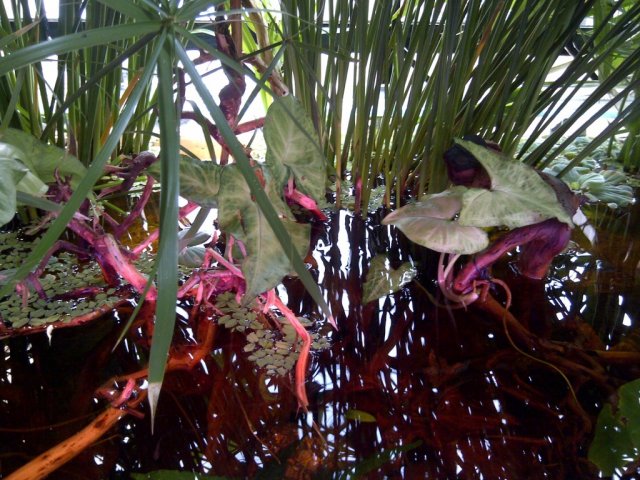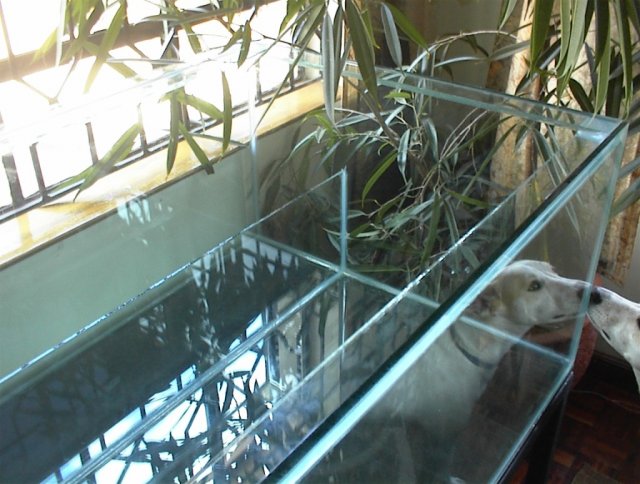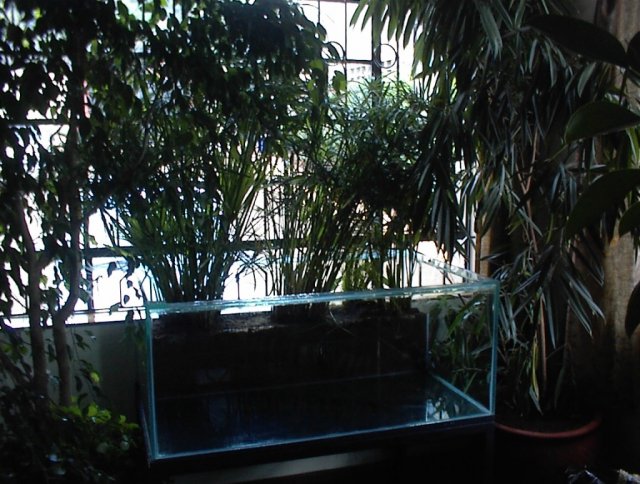Jambo,
two months ago, I set up my tank. The measures are 120cm x 80cm x 50cm (nominally 480 litres / 125 gallon). The tank is open top; it is meant to recreate a Central African swamp stream.
I partitioned off a 25cm high section along the back panel, filled it with garden soil and planted Cyperus alternifolius. Some of the stalks are pushing 2 meters. There also are Salvinia, Pistia, some Echinodorus, a single Anubias nana, Microsorium and Java moss. The Echnidorus will be replaced once I find more Anubias or Bolbitis. I also tied Syngonium and Epipremnum to pieces of wood that stick out of the water. I like the way these plants send their roots into the tank...
Leaf litter (guava, mango and Indian almond) has turned the water dark and I hope acidic. The water in Nairobi is very soft; unfortunately, test kits are not available - so, I have to trust in my experience (I had my first tanks more than 40 years ago), intuition and regular water changes....:eek3:
There is no equipment other than a heater (set to 26C), a single Grolux-type fluorescent (I rely mostly on sunlight) and a Powerhead for circulation.



Currently, I keep 4 Polypterus delhezi (20cm - 30cm); a few feeder guppies also remain in there. I still hope to get Ctenopoma acutirostre, Tetraodon schoutedeni and a pair of Hemichromis.


The Polypterus feed on dried omena (Lake Victoria "sardines); it took them weeks to figure out that guppies are food... erv:
erv:
Greetings from Nairobi
Margit
two months ago, I set up my tank. The measures are 120cm x 80cm x 50cm (nominally 480 litres / 125 gallon). The tank is open top; it is meant to recreate a Central African swamp stream.
I partitioned off a 25cm high section along the back panel, filled it with garden soil and planted Cyperus alternifolius. Some of the stalks are pushing 2 meters. There also are Salvinia, Pistia, some Echinodorus, a single Anubias nana, Microsorium and Java moss. The Echnidorus will be replaced once I find more Anubias or Bolbitis. I also tied Syngonium and Epipremnum to pieces of wood that stick out of the water. I like the way these plants send their roots into the tank...
Leaf litter (guava, mango and Indian almond) has turned the water dark and I hope acidic. The water in Nairobi is very soft; unfortunately, test kits are not available - so, I have to trust in my experience (I had my first tanks more than 40 years ago), intuition and regular water changes....:eek3:
There is no equipment other than a heater (set to 26C), a single Grolux-type fluorescent (I rely mostly on sunlight) and a Powerhead for circulation.



Currently, I keep 4 Polypterus delhezi (20cm - 30cm); a few feeder guppies also remain in there. I still hope to get Ctenopoma acutirostre, Tetraodon schoutedeni and a pair of Hemichromis.


The Polypterus feed on dried omena (Lake Victoria "sardines); it took them weeks to figure out that guppies are food...
Greetings from Nairobi
Margit









